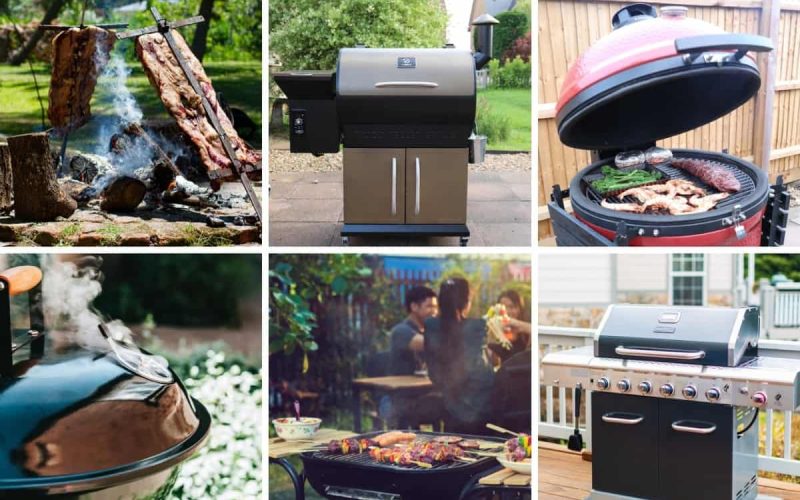Choosing the right grill can transform your backyard cooking experience from ordinary to extraordinary.
With so many options available today, it’s helpful to understand the main types before making your investment.
Whether you prefer the smoky flavor of charcoal, the convenience of gas, or the precision of pellet grills, each type offers unique benefits that can match your cooking style and needs.
Grills come in several major categories including charcoal, gas, and pellet grills, each with distinct advantages.
Charcoal grills deliver that classic smoky flavor that many barbecue enthusiasts crave, while gas grills offer quick startup and precise temperature control.
Pellet grills, a newer innovation, combine convenience with wood-fired flavor that many find irresistible.
If you’re just starting your grilling journey, you might feel overwhelmed by the choices.
Don’t worry – understanding the basics of each grill type will help you make an informed decision.
The nearly 100 models tested by experts show that finding your perfect match depends on your cooking preferences, available space, and how much time you want to spend tending to your grill.
Charcoal Grill
Charcoal grills are beloved classics in the outdoor cooking world, offering that distinctive smoky flavor you simply can’t get from other cooking methods.
These grills use either lump charcoal or briquettes as their fuel source.
The Weber Kettle remains one of the most popular options, known for its affordability, versatility, and strong community support.
This 22-inch model has become the standard that many other charcoal grills are measured against.
Charcoal grills typically come in several main styles:
- Kettle – Round with a domed lid
- Cart and barrel – Horizontal design with side shelves
- Tabletop – Portable, smaller units
- Kamado – Egg-shaped ceramic grills with excellent heat retention
When using a charcoal grill, you’ll enjoy the ability to create both direct and indirect heat zones.
This flexibility lets you sear steaks over high heat while simultaneously slow-cooking larger cuts.
One major advantage of charcoal grills is their dual-purpose functionality.
They excel at both traditional grilling and smoking meats, making them versatile additions to your outdoor cooking arsenal.
Brands like Weber, Char-Griller, and many others offer various models to fit your specific needs and budget.
From basic models to feature-rich options with ash catchers and built-in thermometers, you’ll find something that works for your cooking style.
The main trade-off with charcoal is convenience—they require more setup time than gas grills and have a learning curve for temperature control.
However, many enthusiasts feel the superior flavor is worth the extra effort.
Gas Grill (Propane Or Natural Gas)
Gas grills are popular backyard cooking tools that come in two fuel types: propane and natural gas. Both offer convenience with instant heat and easy temperature control.
Propane Gas Grills
- Portable and can be moved around your yard
- Fuel comes in refillable tanks
- More than twice the BTU power of natural gas
- Higher cost per cooking session
- Great for occasional grillers
Propane tanks are easy to replace when empty, giving you flexibility. You don’t need a permanent gas line, making propane grills ideal for renters or those who like to grill in different locations.
Natural Gas Grills
- Connected to your home’s gas line
- Never run out of fuel mid-cookout
- Lower operating costs over time
- Requires professional installation
- Less portable (fixed in place)
When shopping for a gas grill, remember that you cannot use natural gas with a propane grill, or vice versa. The gas orifices are sized differently to accommodate each fuel type.
Both types offer similar cooking experiences with quick startup, easy cleaning, and precise heat control. Your choice depends on your living situation, budget, and how you plan to use your grill.
Many manufacturers offer conversion kits, but professional installation is recommended for safety reasons when switching between fuel types.
Electric Grill
Electric grills offer a convenient cooking solution for people with limited outdoor space or those facing restrictions on open flames. You don’t need to worry about propane tanks or charcoal when using these grills.
The market offers several excellent options in 2025. The Weber Q 1400 Electric Grill stands out as one of the best portable choices, while the Char-Broil Patio Bistro works great for patios.
Benefits of Electric Grills:
- No flare-ups
- Even heat distribution
- Juicier food results
- No charcoal or gas needed
- Often apartment-friendly
Electric grills plug into standard outlets, making them incredibly easy to use. Simply turn them on, set your temperature, and you’re ready to cook in minutes.
Many models come in tabletop versions perfect for small spaces. Others feature stands similar to traditional grills for a more authentic grilling experience.
Temperature control tends to be more precise with electric grills. You can adjust the heat with dials or digital controls depending on the model.
Food & Wine magazine tested over 20 electric grills to identify the most reliable models for cooking meats and vegetables. Their research shows these grills can deliver excellent results despite not using flames.
You can find electric grills at many retailers including The Home Depot, which offers popular models like the Weber Q 2400 and Q 1400 series.
Pellet Grill
A pellet grill combines the best features of a smoker, oven, and traditional grill into one versatile cooking device. Unlike charcoal or gas grills, pellet grills use small wood pellets as fuel, giving your food that delicious wood-fired flavor.
These grills work by feeding wood pellets from a storage hopper into a fire pot where they’re ignited. The digital controller maintains your chosen temperature by adjusting the pellet feed rate—no more constant temperature monitoring!
Key Benefits of Pellet Grills:
- Precise temperature control (usually within 5-10 degrees)
- Even cooking with indirect heat
- Versatility to smoke, grill, roast, and even bake
- Less hands-on attention needed during cooking
When shopping for a pellet grill, you’ll want to consider several important features. Hopper size affects how long you can cook without refilling, while cooking space determines how much food you can prepare at once.
Many modern pellet grills offer impressive tech features. Wi-Fi connectivity lets you monitor and adjust your cooking from your smartphone, while some models include side burners for preparing sauces or side dishes.
Popular brands like Recteq, Camp Chef, and Pit Boss have earned loyal followings for their quality and performance. According to testing by Serious Eats, the best pellet grills excel at maintaining steady temperatures while producing excellent smoke flavor.
Cleaning is straightforward with most models featuring removable drip trays and ash collection systems. Just remember that pellet grills do require electricity to operate their digital components.
Kamado Grill (Ceramic Grill)
Kamado grills are distinctive egg-shaped cookers that have ancient origins but modern appeal. These versatile cooking vessels are typically made from ceramic materials that provide superior heat retention compared to standard grills.
You can recognize a kamado grill by its thick walls and dome-shaped lid. The most well-known brands include Big Green Egg and Kamado Joe, which offer various sizes to suit different cooking needs.
The ceramic construction creates an incredibly efficient cooking environment. Your kamado can maintain temperatures between 225°F and 750°F, making it perfect for everything from slow smoking to high-heat searing.
Key benefits of kamado grills:
- Excellent heat retention and efficiency
- Moisture-locking design that keeps food juicy
- Versatile cooking options (smoking, roasting, grilling)
- Long lifespan with proper care
When using your kamado, you can try several cooking methods including indirect cooking, smoking, roasting, and direct grilling. The two-zone cooking technique is particularly useful for more complex recipes.
Kamado grills require less charcoal than traditional grills because of their efficiency. A small amount of lump charcoal can maintain cooking temperatures for 12+ hours during low and slow cooking sessions.
While the initial investment is higher than standard grills, ceramic kamados often last decades with minimal maintenance, making them a worthwhile investment for serious outdoor cooking enthusiasts.
Infrared Grill
Infrared grills are a modern cooking solution that sets them apart from traditional gas and charcoal options. Unlike conventional grills that use open flames to heat the air, infrared grills emit energy that directly heats your food.
These specialized grills use infrared technology to create intense, evenly distributed heat. You’ll experience fewer flare-ups and more consistent cooking results when using this technology.
There are several types of infrared burner systems you might encounter:
- Ceramic Infrared Burners – The most common type
- Radiant Glass Panel Systems – Pioneered by TEC
- Metal Infrared Plates – Used in some models
Ceramic infrared burners are particularly popular and can reach extremely high temperatures—perfect for searing steaks and achieving restaurant-quality results at home.
The benefits of cooking with an infrared grill include:
- Faster preheating – Ready to cook in minutes
- Higher cooking temperatures – Often exceeding 700°F
- More even heat distribution – No cold spots
- Juicier results – Less moisture loss during cooking
Many brands now offer grills with infrared technology, either as dedicated infrared units or as hybrid models with both conventional and infrared burners.
When shopping for an infrared grill, you’ll want to consider size, BTU output, and construction quality. Monument Grills and other manufacturers design their infrared models for efficiency and precision cooking.
Portable Grill
Portable grills offer you convenience and flexibility for cooking outdoors when space is limited or you’re on the go. These compact cooking stations come in various fuel types to suit your preferences.
The best portable grills of 2025 have been thoroughly tested by experts who evaluated nearly 100 different models. This testing helps you find options that combine quality with mobility.
You can choose between several fuel types:
- Charcoal portable grills – Great for traditional smoky flavor
- Propane gas grills – Quick to start and easy to control
- Natural gas models – Less common but available for consistent cooking
Popular Brands to Consider:
- Weber
- Napoleon
- Coleman
- Char-Broil
- Cuisinart
- Snow Peak
Many retailers like The Home Depot offer a wide selection of portable options. You’ll find models ranging from budget-friendly to premium options.
When shopping for your portable grill, consider the size that works best for your needs. Napoleon’s portable charcoal grills come in different sizes including 18″ and 22″ models.
Weight is another important factor if you’ll be carrying your grill frequently. The lightest models are designed specifically for camping and hiking adventures.
Most portable grills are designed for tabletop use, but some include foldable stands. This gives you more flexibility when cooking at beaches, parks, or campsites where table space might be limited.
Smoker Grill
Smoker grills offer you the best of both worlds – the ability to grill food quickly and smoke it slowly for rich, deep flavor. These versatile cooking devices use smoke from burning wood or charcoal to infuse food with distinctive tastes.
There are several popular types of smoker grills you might consider for your backyard cooking adventures:
Offset Smokers: These have a main cooking chamber with a smaller firebox attached to the side. Smoke travels from the firebox through the cooking chamber, creating that classic smoky flavor you love. Offset smokers are particularly popular among barbecue enthusiasts.
Vertical/Box Smokers: These stand upright with the heat source at the bottom and multiple cooking racks above. You’ll find they’re space-efficient and excellent for smoking large quantities of food at once. They’re among the different types of barbecue smokers gaining popularity.
Pellet Smokers: These use wood pellets as fuel and offer precise temperature control with minimal effort. Many models can be programmed to maintain consistent temperatures for hours, making them user-friendly options for beginners.
Kamado Grills: These egg-shaped ceramic cookers retain heat exceptionally well. You can use them for both high-temperature grilling and low-and-slow smoking, giving you impressive versatility.
Drum Smokers: Simple in design but effective in performance, drum smokers are often more affordable than other types. Many barbecue fans even build their own from steel drums!
When choosing your smoker grill, consider factors like cooking capacity, fuel type, temperature control, and your budget. Your perfect smoker depends on your specific cooking needs and experience level.
Hybrid Grill (Multi-Fuel)
If you’re struggling to choose between gas and charcoal, a hybrid grill might be your perfect solution. These versatile cooking stations offer the best of multiple worlds by combining different fuel types in a single unit.
Hybrid grills from Char-Broil feature both gas and charcoal cooking options in one convenient package. You get the quick convenience of gas when you’re in a hurry and the authentic smoky flavor of charcoal when time allows.
The most common hybrid configuration is a dual fuel grill that splits the cooking area into two sections – one side for charcoal and one for gas or propane. This setup gives you incredible flexibility for different cooking situations.
Some advanced multi-fuel models go beyond the basic gas-charcoal combination. These premium options may include:
- Gas burners for quick heating
- Charcoal chambers for traditional grilling
- Wood pellet sections for smoking
- Natural gas compatibility with proper setup
The benefits of choosing a hybrid grill include:
- Versatility – cook with whatever fuel suits your recipe
- Convenience – use gas when short on time
- Flavor options – enjoy authentic charcoal taste when desired
- All-in-one solution – save space compared to owning multiple grills
When shopping for a hybrid, consider the BTU rating, cooking surface area, and build quality. Higher-end models offer patented multi-fuel trays that allow for easy switching between fuel types.
Open Fire/Wood-Burning Grill
Wood-burning grills bring cooking back to basics with their primal, open-fire approach. These grills let you harness the power of flames directly, creating food with distinctive smoky flavors that other cooking methods simply can’t match.
You’ll find several styles of wood-fired grills inspired by Argentine grilling traditions. These premium options feature adjustable grates that let you control cooking temperatures by raising or lowering the food above the flames.
When selecting woods for your fire, consider these options:
- Oak – Provides steady, long-lasting heat
- Hickory – Adds rich smoky flavor
- Maple – Burns clean with subtle sweetness
Many open fire grills come in both freestanding and portable designs. This flexibility lets you enjoy wood-fired cooking at home or take the experience camping.
The design of wood grills varies from simple to sophisticated. Most feature:
- Adjustable grill grates for temperature control
- Heavy-duty steel construction
- Fire brick lining for heat retention
- S-hooks for hanging tools
You can find Santa Maria-style grills that use a wheel mechanism to raise and lower the cooking surface. This traditional approach gives you precise control over how quickly your food cooks.
Modern wood grills often include convenient features like acacia wood tables for food prep. These thoughtful additions make the rustic cooking method more accessible for everyday use.








